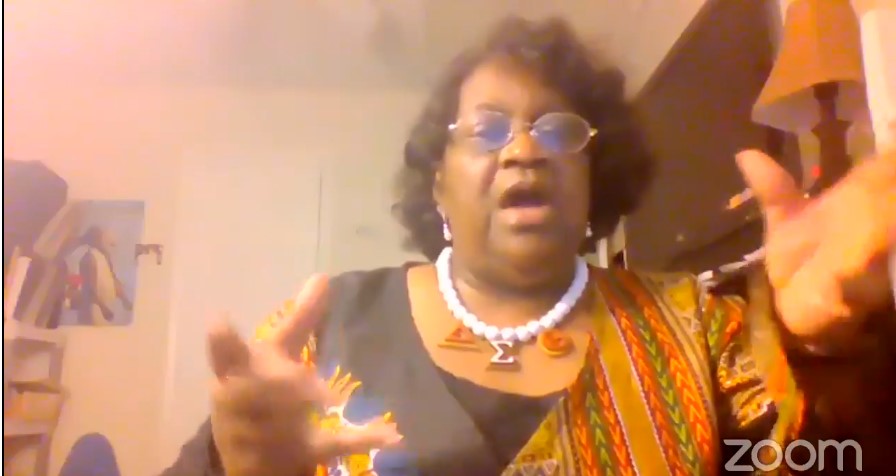Female voices of the Orangeburg Massacre
By: LAUREN PRINGLE
Feb 09, 2021

Lorraine Gaillard speaks during the Feb. 4 Zoom conference.
Every year on Feb. 8, Orangeburg comes together to grieve for the students who lost their lives in the cataclysm that took place 53 years ago at South Carolina State University, the Orangeburg Massacre.
To honor the students, spread awareness and give insight on the roles that women played during the time, the I.P. Stanback Museum and Planetarium at S.C. State held a panel discussion via Zoom on Feb. 4. Featured were three women who were prominent figures in the Orangeburg Massacre, the Feb. 8, 1968, incident during which three students were killed and 28 injured when state troopers opened fire on protesters seeking desegregation of a local bowling alley.
The panelists were Marie Hamberg Artis, Lorraine Gaillard and Minnie Haynes. Each was present and affected during the Orangeburg Massacre.
Dr. Valinda Littlefield, a scholar in the study of the history of African American women and associate professor of history at the University of South Carolina, moderated the event, asking about women taking an active role in fighting for civil rights.
Haynes described a time during her childhood when she was bitten by a dog and then taken to a hospital, where she was greeted by an uncivil nurse. “I was thrashing about and yelling, and a white nurse came up to me and slapped me in my face.”
The nurse then proceeded to tell Haynes to shut up. “This (among other things) led me to have a desire to get rid of this cancer (racial injustice) that was spoken about.”
Artis explained that when she was a child, she would walk to the end of street to catch her bus. Right across the street was a heavily white-populated school.
“We only had five buses for our school, we had the secondhand books, and we had to wait in line for everything. … We used to be at the bus stop, and it would be cold and rainy, and we would make a fire and talk amongst ourselves as little kids and tell each other there must be a better way. We wanted to cross that street,” Artis said.
“When I came to S.C. State … it was just something I knew I had to do, as most African American women did at that time to bring about some change for improvement in regard to civil rights.”
“I grew up in a segregated society. I grew up where racial discrimination and all manner of derogatory remarks were made out in public. It was something that was done, and no one said anything about it,” Gaillard said.
She used to get on the bus with her family to go home and would always notice a big sign stating that coloreds need to go to the back of the bus.
“As a young child, I kept wondering why is this? Our blood runs red just like everybody else. We are human just like everybody else,” Gaillard said. This prompted Gaillard to start her journey as an advocate for civil rights.
All women faced different types of racial discrimination and segregation at a young age, resulting in them having a strong desire and impulse for change throughout the African American community, Gaillard said.
As to the Orangeburg Massacre and individual experiences during that time, Haynes, a former professor at S.C. State and a teacher in 1968, recalled trying to keep the students calm and safe when everything took place.
“The tension was rising fast and furiously,” Haynes said. Some of the students wanted to get involved and participate but knew that their parents would be devastated if anything happened to them.
“It was a pleasure to try and give them the reassurance that they needed, that they could express themselves to me. … I was turning out a lot of aguish as well as during that time, and so were they.”
Artis was a student in her dormitory when the tragic events of 1968 took place.
“We started hearing screaming and yelling from males and females,” Artis said. She mainly saw males walking down the street, crying and screaming. “It was a real essence of fear and confusion.”
She and her friends went to the infirmary to see if they were able to assist in any way possible.
“During the massacre, fear was redefined, because you were on the campus during all of this … tanks were all around the campus. No one was allowed on campus and we weren’t allowed off campus,” Artis said. “During that time there was a lot of emotional strain and a lot of uncertainty -- just not understanding and not knowing what the next move might be.”
An S.C. State student, Gaillard and her friends went downtown during that week in 1968. On the way back to campus, Gaillard noticed the “Whites Only” sign on the wall of the bowling alley and she and her friends went to question the sign.
They went up to the door as asked how much it would be to bowl and the owner responded by saying the business did not serve African Americans. Word got around campus about what the ladies had done, and the incident was the straw that broke the camel’s back.
The night of Feb. 8, all the boys made sure the females were in their dorms. All the males went to the front of the campus. Gaillard watched from afar from her room.
“Next thing you know, we saw sparks and heard this thunder. … All the campus police raced to the edge of campus,” Gaillard said. “A short while later, the guys and young ladies were seen running and screaming and that was one of the scariest moments I have experienced.”
She remembered thinking it was like war. “It was mass hysteria. I don’t like talking about it because it feels like it happened two weeks ago.”